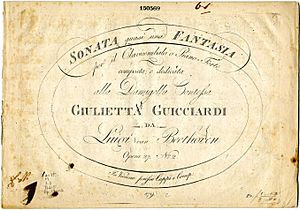Piano Sonata No. 14 (Beethoven) facts for kids
The Piano Sonata No. 14 in C-sharp minor, also known as the Moonlight Sonata, is a famous piece of music for the piano. It was written by the famous composer Ludwig van Beethoven. He finished it in 1801 and gave it to his student, Countess Giulietta Guicciardi, in 1802. This sonata is one of Beethoven's most loved and well-known pieces.
Contents
What's in a Name?
When Beethoven first published this music, he called it Sonata quasi una fantasia. This means "sonata in the style of a fantasy." He used this same title for another one of his piano sonatas, too. A "fantasy" in music means a piece that doesn't strictly follow the usual rules of how music is put together.
The popular name "Moonlight Sonata" came much later. In 1832, a German music critic and poet named Ludwig Rellstab said that the first part of the music reminded him of moonlight shining on Lake Lucerne. Many people liked this idea. Within ten years, the name "Moonlight Sonata" was used everywhere in German and English.
Some music experts don't like the name "Moonlight Sonata." They think it makes people imagine something too soft and dreamy, when parts of the music are actually quite serious. However, others think the name is fine because it helps people remember the piece. The founder of Gramophone magazine, Compton Mackenzie, said the name was "harmless." He felt that if people didn't connect with the idea of moonlight in the music, the name would have been forgotten.
How the Music Is Built
Beethoven called this piece a "sonata in the style of a fantasy" because it doesn't follow the usual structure of a sonata from his time. Usually, a sonata would start with a fast, exciting part. But the Moonlight Sonata starts slowly and calmly. The faster, more complex music comes later in the piece.
This sonata has three main parts, called movements:
- Adagio sostenuto (very slow and sustained)
- Allegretto (fairly quick and lively)
- Presto agitato (very fast and agitated)
First Movement: Adagio sostenuto
This first part is the most famous. It is slow and quiet, often played very softly. It has a dreamy, almost sad feeling. This is the part that reminded Ludwig Rellstab of moonlight.
Second Movement: Allegretto
The second movement is much lighter and quicker than the first. It's like a short, cheerful break between the serious first part and the dramatic last part.
Third Movement: Presto agitato
The final movement is very fast and powerful. It's full of energy and drama, with quick notes and strong feelings. It's a big contrast to the quiet beginning of the sonata.
Images for kids
See also
 In Spanish: Sonata para piano n.º 14 (Beethoven) para niños
In Spanish: Sonata para piano n.º 14 (Beethoven) para niños


